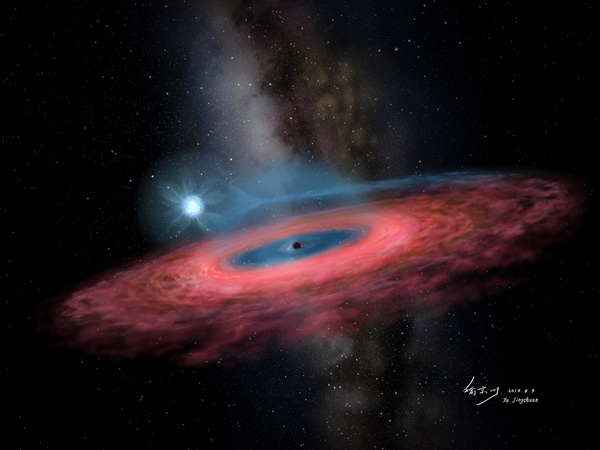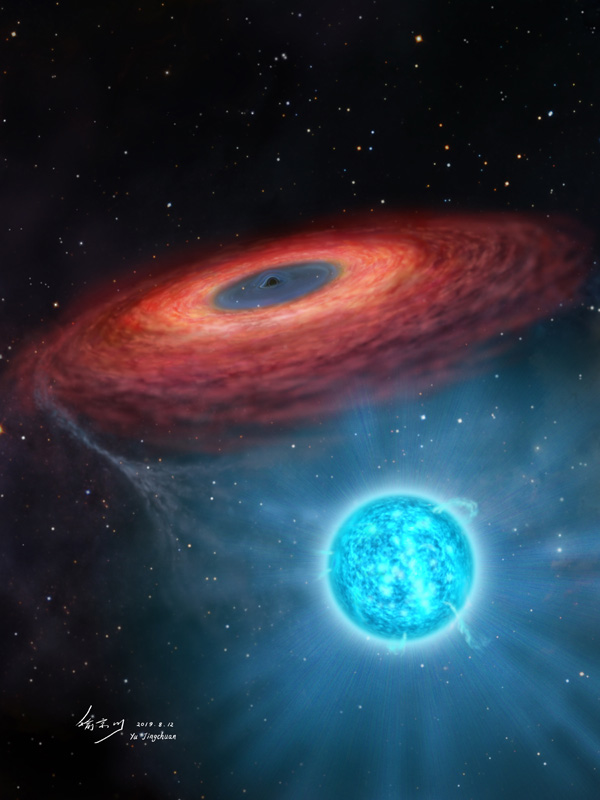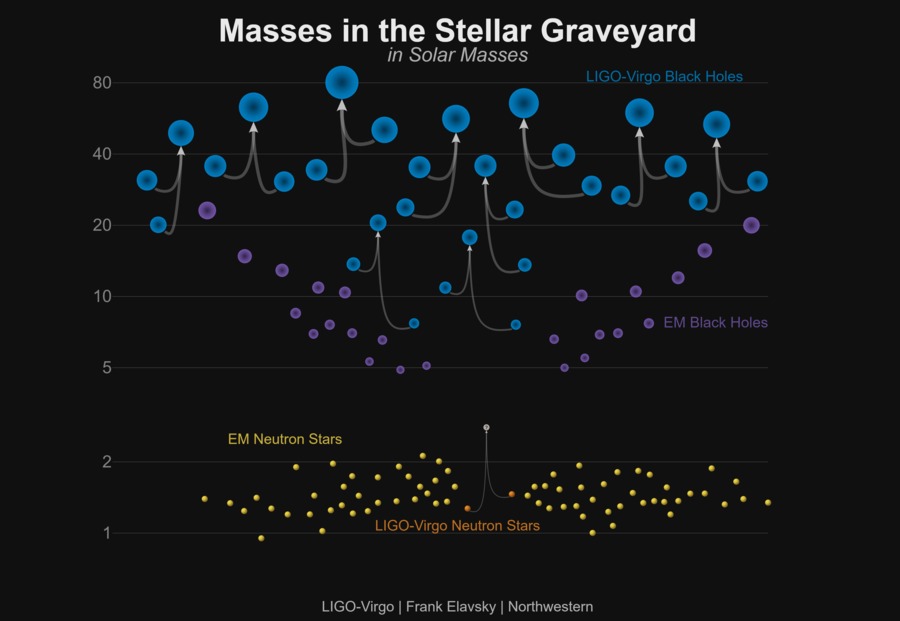Heavyweight Black Hole Find Mystifies Astronomers – Sky & Telescope
Observations of a star have found it orbiting an unexpectedly massive black hole. If the discovery pans out, it would change our understanding of how massive stars die.

An artist’s concept shows a hot, young star orbiting a black hole.
Jingchuan Yu / Beijing Planetarium
Astronomers have found a seemingly “impossible” black hole about 14,000 light-years away. Their observations, published in the November 28th Nature, suggest that the weird object weighs in at a staggering 68 times the mass of the Sun.
While much heftier black holes, dubbed supermassive, reside in the cores of most large galaxies, theories predict an upper limit of some 45 to 55 solar masses for a “stellar-mass” black hole that forms in the aftermath of a supernova explosion. According to Craig Wheeler (University of Texas, Austin), “This is clearly an interesting story, if verified.”
Stellar wobbles
So far, most stellar-mass black holes have been discovered via X-rays emitted by their hot accretion disks. But the new find didn’t show up in Chandra observations — it is truly invisible. Instead its existence was betrayed by the periodic wobble of a young, hot B-type subgiant star about eight times the mass of the Sun. This 11.5-magnitude star is in the westernmost part of Gemini. A survey carried out with the Chinese Large-sky Area Multi-Object Fiber Spectroscopic Telescope (LAMOST) revealed the star’s motions toward and away from Earth as it orbited . . . something.
According to the team, led by Jifeng Liu (National Astronomical Observatories, Chinese Academy of Sciences), the star’s orbital period of 78.9 days and the observed velocity indicate that its companion has at least six times the Sun’s mass. Hence, it must be a black hole, because a star of that mass would be clearly visible. But that’s just its minimum mass — if we happen to be viewing the binary system from a steeper angle rather than exactly edge-on, the mass of the dark object could be much larger.

Another view of the star orbiting a monster of a stellar-mass black hole.
Jingchuan Yu / Beijing Planetarium
Here’s where the new discovery becomes intriguing: The spectroscopic data also show a broad emission line from ionized hydrogen, called hydrogen alpha, that does not move together with the other lines in the star’s spectrum. Instead, the line comes from something moving only one-eighth the speed of the star in its orbit. What’s more, its motion is opposite the star’s, moving toward Earth as the star moves away and vice versa. These characteristics are just what you would expect for the star’s binary companion.
If the hydrogen-alpha emission originates in a large disk of hot gas orbiting the black hole, as the authors argue, then the observed velocity ratio translates directly into a mass ratio, indicating that the black hole is a whopping 68-solar mass monster. The corresponding distance between the black hole and the star orbiting it would be some 225 million kilometers, or 1.5 astronomical units (a.u.), comparable to the distance between Mars and the Sun.
Excitement vs. Skepticism
“About a week before the Nature publication, I received an email from the authors, around 2:45 a.m.,” says astrophysicist Selma de Mink (Center for Astrophysics, Harvard & Smithsonian). “I happened to be briefly awake, and habitually checked my phone. Bad idea. Couldn’t sleep anymore until the next morning.” The reason: 68-solar mass black holes shouldn’t exist.
“I’d love this to be true,” says de Mink, “since I really like mysterious puzzles about binary stars and black holes. But the hydrogen-alpha measurements are extremely difficult. I’m not yet convinced.”
Supernova expert Stan Woosley (University of California, Santa Cruz) is also skeptical of the high-mass claim. Extremely massive stars generally lose huge amounts of gas through stellar winds before they explode as supernova, especially when they are born in environments with relatively large amounts of elements heavier than hydrogen or helium (or metals, in astronomical parlance). That happens to be the case here: The accompanying star has some 20% more metals than the Sun.
“Of course, mass loss rates are notoriously uncertain,” Woosley admits. Still, he says no one expects a black hole 68 times as massive as the Sun to form in a region of near-solar metallicity. “This would be a qualitative change – hence interesting, but also requiring very compelling evidence. Thus, I remain skeptical, but I’m just a theorist. Observations rule.”
Team member Stephen Justham (University of Amsterdam) thinks the hydrogen-alpha measurements, on which everything hinges, are convincing enough to justify excitement. The LAMOST observations are supported by higher-precision data from the 10-meter Keck I and GranTeCan telescopes in Hawai’i and the Canary Islands, respectively. “If someone comes up with a better interpretation [for the motion of the hydrogen-alpha line], I’ll be very interested to hear,” he says.
Then again, Justham agrees that individual stars shouldn’t form such massive black holes, and he fully realizes “how shocking it would be” if the simple 68-solar mass black hole interpretation is true. For that reason, he suggested the idea that the dark mass in the binary system is not one massive black hole, but a close pair of them, each some 35 times the mass of the Sun.

This plot shows the masses of black hole mergers detected by the LIGO and Virgo gravitational wave detectors (blue), as well as the black holes detected via X-ray emission (purple). Also shown are neutron stars (yellow) and the LIGO-detected neutron star merger (orange). Click to see a larger version.
LIGO / VIrgo / Northwestern Univ. / Frank Elavsky
Indeed, LIGO and Virgo have detected gravitational waves from the mergers of black holes of up to 50 solar masses. So the new discovery could be a pre-merger binary black hole. Or maybe the pair has already merged, although that would be unlikely, given the young age of the system — the companion star is only 35 million years old.
There’s one additional problem. Parallax measurements by the European Space Agency’s Gaia spacecraft yield a distance of just 7,000 light-years to the star – twice as close as assumed based on the star’s spectrum and inferred true luminosity. However, the researchers note that the Gaia measurements are not very clean and are probably affected by the star’s binary wobble.
If Gaia’s distance measurement is true, however, then both the star and its invisible companion could be substantially less massive. At the same time, though, astronomers would have to assume that the star is in a rare out-of-equilibrium state in order to make it much less luminous than you would expect for a hot, young star of this type.
Follow Up and Future Finds
“I hope that the team will make their spectra publicly available,” says de Mink, “so that independent scientists can check the results.” She expects that it won’t be long before other telescopes will be trained on the system, carrying out new measurements. “Let’s see what happens.”
Woosley agrees there’s ample opportunity for more observations. “The system isn’t going anywhere,” he quips. Meanwhile, Justham thinks that future spectroscopic surveys will turn up many more quiescent black holes in binary systems. “Whatever the exact mass of this one,” he says, “it’s a taste of a future black hole population we’re only just starting to be able to discover.”






